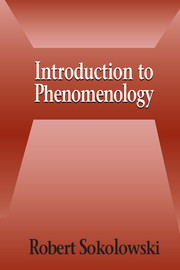Book contents
- Frontmatter
- Contents
- Acknowledgments
- Introduction
- 1 What Is Intentionality, and Why Is It Important?
- 2 Perception of a Cube as a Paradigm of Conscious Experience
- 3 Three Formal Structures in Phenomenology
- 4 An Initial Statement of What Phenomenology Is
- 5 Perception, Memory, and Imagination
- 6 Words, Pictures, and Symbols
- 7 Categorial Intentions and Objects
- 8 Phenomenology of the Self
- 9 Temporality
- 10 The Life World and Intersubjectivity
- 11 Reason, Truth, and Evidence
- 12 Eidetic Intuition
- 13 Phenomenology Defined
- 14 Phenomenology in the Present Historical Context
- Appendix: Phenomenology in the Last One Hundred Years
- Select Bibliography
- Index
5 - Perception, Memory, and Imagination
Published online by Cambridge University Press: 05 June 2012
- Frontmatter
- Contents
- Acknowledgments
- Introduction
- 1 What Is Intentionality, and Why Is It Important?
- 2 Perception of a Cube as a Paradigm of Conscious Experience
- 3 Three Formal Structures in Phenomenology
- 4 An Initial Statement of What Phenomenology Is
- 5 Perception, Memory, and Imagination
- 6 Words, Pictures, and Symbols
- 7 Categorial Intentions and Objects
- 8 Phenomenology of the Self
- 9 Temporality
- 10 The Life World and Intersubjectivity
- 11 Reason, Truth, and Evidence
- 12 Eidetic Intuition
- 13 Phenomenology Defined
- 14 Phenomenology in the Present Historical Context
- Appendix: Phenomenology in the Last One Hundred Years
- Select Bibliography
- Index
Summary
We now have an idea of what phenomenological analysis is and why it is philosophical. We have also gone through an example of such analysis in our examination of the perception of a cube. We have considered the role played in human experience by the structures of parts and wholes, identity in manifolds, and presence and absence. We can now begin to amplify all these themes by developing yet more phenomenological descriptions. What we have done so far have been only preliminary sketches. We will now go back to perception and examine in greater detail how it presents objects to us, and how it is played off against derivative forms of intentionality such as remembering, imagination, and projection into the future.
REMEMBERING
Perception directly presents an object to us, and this object is always given in a mixture of presences and absences. When one side is given, others are absent. Some parts of the object conceal other parts: the front hides the back, the surface hides the inside. If the object is one that we hear, then hearing it at one place excludes the aspects of sound that would be available at another. We can overcome such absences, but only at the cost of losing presences we have, which become absent. Throughout this dynamic blending of presence and absence, throughout this manifold of presentation, one and the same object continues to present itself to us. The identity is given in a dimension different from that of the sides, aspects, and profiles; the identity never shows up as one of the sides, aspects, or profiles.
Information
- Type
- Chapter
- Information
- Introduction to Phenomenology , pp. 66 - 76Publisher: Cambridge University PressPrint publication year: 1999
